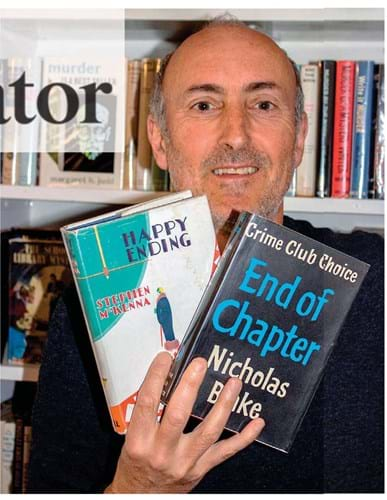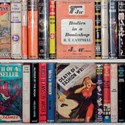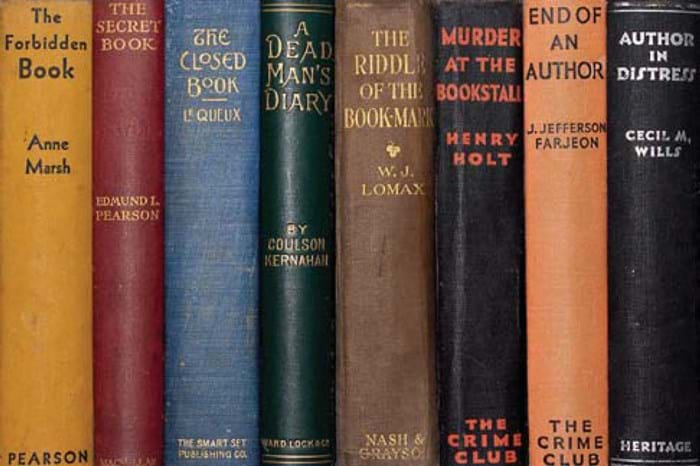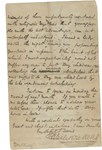ATG: What made you begin the collection?
Jeremy Carson: Twenty years ago I was a special-needs teacher with a wife, young family, a mortgage and a passion for book collecting. I was buying haphazardly, as novices do, but I had just managed to get into the ‘trade only’ inner sanctums of the local bookshops. Even with my limited knowledge these were clearly treasure troves of potential fun and profit.
I began to try a few local book fairs to get ‘book money’ to fund my habit. One day a dealer grabbed a book from my own £1 box and said “Ah, a bibliomystery.”
And that was it. I knew what I was going to collect. I loved murder mysteries and I loved old books, and I’d stumbled on a sub-genre that combined both pleasures.
Of course, you could argue that selling a really rare one for £1 was not a great way to start.
What exactly is a ‘bibliomystery’?
It’s in the name! A bibliomystery is crime fiction involving books and, somewhat elastically, everything else that goes with them: from agents, printers and publishers to writers, libraries and bookshops.
The book that got away that day is a great example: Death Among The Writers by Edwin De Caire. It took me 10 years to track down another copy and I eventually paid £90 for one in a dust jacket.
There are two for sale online now; the cheap one is a very ambitious £300. It’s beautifully written, something you can’t say for many of my little treasures. Most are terrible and some are virtually un-readable. But one of the best things about book collecting is not having to read them; we want them for what they are.
How did you fund the collection?
I quickly realised that some titles such The Body In The Library by Agatha Christie were going to be impossible unless I did something drastic. Back then AbeBooks had just started and there were gorgeous books like that on it and I simply couldn’t afford them. My teacher’s salary all went to the household.
So, I took the plunge and began selling on eBay in about 2000, catching the end of an astonishing period when old books were going for great money. Thanks to those ‘trade only’ back rooms I was soon treating myself to a guilt-free £350 copy of the Christie. That’s the most expensive one, because of the author. Most of them were £10 or £20 because at that time virtually nobody else was looking for them.
Crime fiction is top-dollar but always collected by author or publisher, neither of which mattered to me. Focusing on a theme instead is great fun, very rewarding and a lot cheaper.

This near-mint 1942 Christie first edition of 'The Body in the Library' was £350 in 2002. A copy now would be double that.
How many do you have?
About 500. There are thousands of others in this sub-genre but I wanted only obvious ones with good titles.
Bodies in A Bookshop sounds like a plea for more customers; The Library of Death would be a cause for concern for any local authority.
On the other hand, the title Murder Is A Best Seller is rather poignant for me because the collection led to my becoming a professional book dealer.
My desire to add to the collection meant I never stopped selling online and at fairs. In 2015 I went full-time as a dealer and I’m now in the PBFA and heartily looking forward to the fairs starting again.
Thus, my own life is entwined with bibliomysteries.
Featuring on a theme instead of author or publisher is great fun, very rewarding and a lot cheaper
A personal favourite...?
Bernard J Farmer was a book collector and author and his 1956 Death of A Bookseller is probably the ultimate bibliomystery. The action is set in the heart of London’s old-book world, from seedy knocker-boys on the Farringdon Road barrows to Mayfair’s swanky shops and auction houses.
There are even visiting American dealers, regarded with awe by the rest of the cast. All of them, it seems, are prepared to kill for Keats’s own copy of Endymion. It’s a superb read for the book-lore alone.
I’m glad to say that thanks to crime-fiction author Martin Edwards the book is being reissued this autumn by The British Library. It’s a popular book in our trade already as you can imagine.
The ‘Murder and Mayhem’ shop in Hay-on Wye had a ‘not for sale’ copy propped up behind the counter at one time. I paid £90 for mine in 2010. I’ve got a proof copy too, which cost 10 pence from a summer fete in Devon. I like to think that Farmer would be delighted with both examples.
Did you discover others who share your interest?
Oh yes. After all, who can resist a book called The Secret of The Human Bookcase?
I put an advert in Book and Magazine Collector and somebody sent me a photocopy of a 1989 catalogue of a 500-title collection. The Title Is Murder, The Body on Page One, Murder in Volume Two… these books were writing their own story. I had no idea any of them existed until that kind stranger answered the ad.
That first big collection was built up by husband and wife dealers Emily and John Ballinger of The Bookpress, Virginia. They too had been hooked by the wonderful symmetry of collecting books about books.
I was soon in touch with dealers from all over the country and my own collection grew. In 2008 I published a checklist in Book and Magazine Collector; I ended up writing a column about books in general.
What was your collecting strategy?
This will sound familiar to many readers: it’s a mixture of luck, good contacts and hard work. And longevity, I suppose.
With no real rules I set my own boundaries to the collection. The main criteria were the title, content and a personal cut-off date of 1970. Back then ‘modern’ books were easy to find, no real challenge and often very expensive.
This was right in the middle of the ‘hyper-modern’ craze and I was an antiquarian at heart. I visited specialist dealers across the country and read a million blurbs. Everyone recognises another addict.
Another key moment was getting a CD-Rom of Hubin, the enormous bibliography of crime fiction. It’s not searchable but does list 110,000 titles alphabetically.
I realised that, statistically, there had to be hundreds about bookshops, authors, manuscripts and libraries. I read it from start to finish – it took a month - and made a huge list of titles not in that first catalogue. I managed to snap up a lot right there and then off the internet.
Could this collection be made again?
It’s often said that the mark of a truly great collection is that it could not be repeated. Mine would be difficult but not impossible, mainly because bibliomysteries have taken off in a big way this century.
There are even a few specialist dealers such as The Usual Suspects in Canada.
Plenty of modern titles and old ones turn up at fairs and on the internet. In fact, fiction about hidden or magical books seems to be all over the place now.
Frankly, with my dealer hat on, I’d recommend going for a different ‘theme of the crime’. Art, fashion, film or cookery are glamorous areas which attract money. There are hundreds of thrilling titles for each and it’s easy to imagine a celebrity snapping up a wall of colourful old mysteries in their particular line.
The key thing about murder-mysteries is there are so many of them. The nearest one I can think of for ATG readers is Richard Keverne’s 1928 William Cook, Antique Dealer. Although the less said about Michael Nelson’s 1958 Knock or Ring the better – as the title suggests, it’s about dodgy book auctions.
Are you still adding to the collection?
Oddly enough, no. I adore them and still own them; they’re a part of my life. But I eventually realised I had most of the ones I wanted and was never going to find the others. They really are so rare they may as well not exist, or so expensive I simply couldn’t justify it any more. It was very liberating to ‘let go’ of the obsession and still keep the collection. Of course, I do happen upon odd titles now and again, but they come to me - I don’t seek them out.
That might be some sort of secret to happiness, by the way. Collecting can get out of hand and is a strange activity if you over-analyse it. For now, at least, Nicholas Blake’s End of Chapter seems a good place to stop.




















